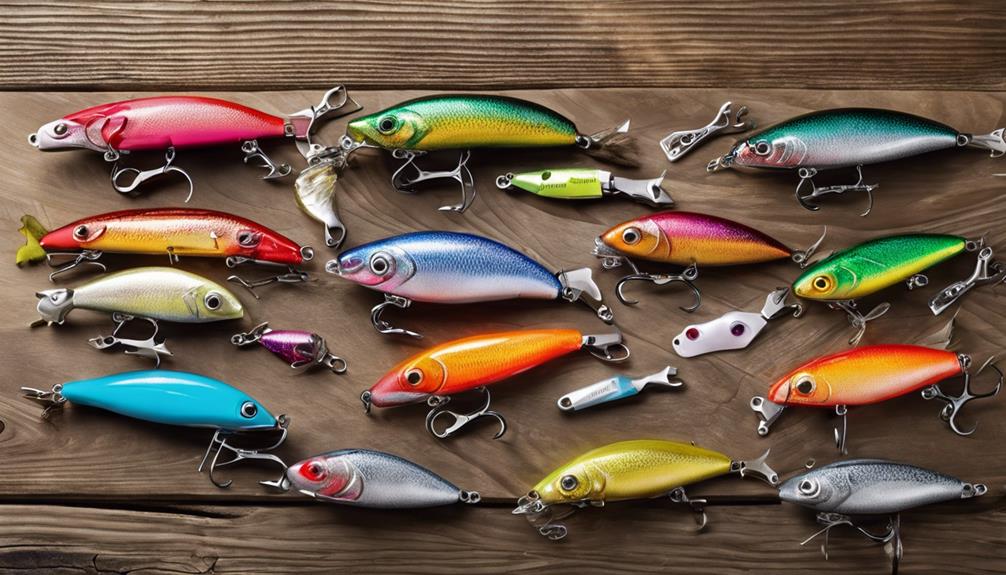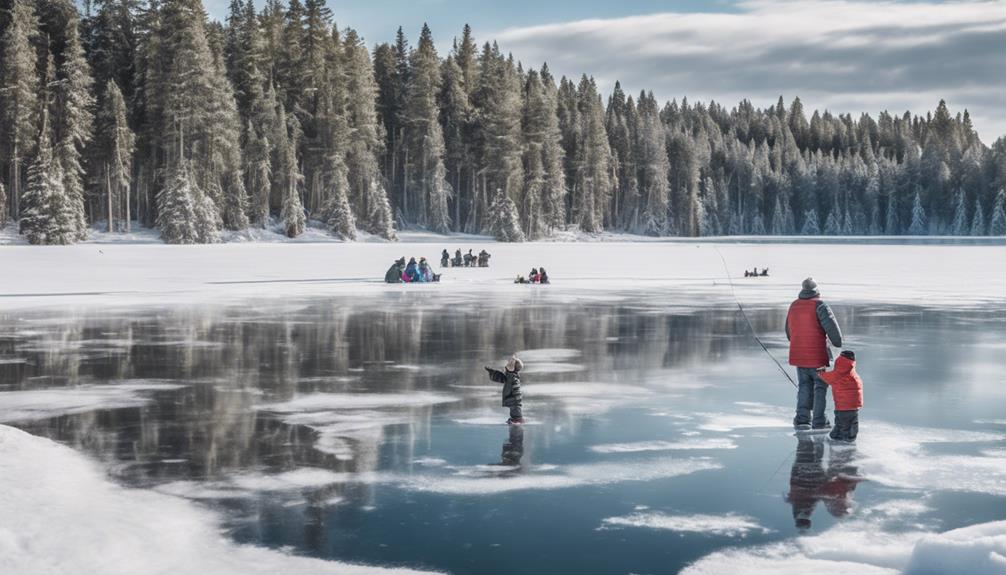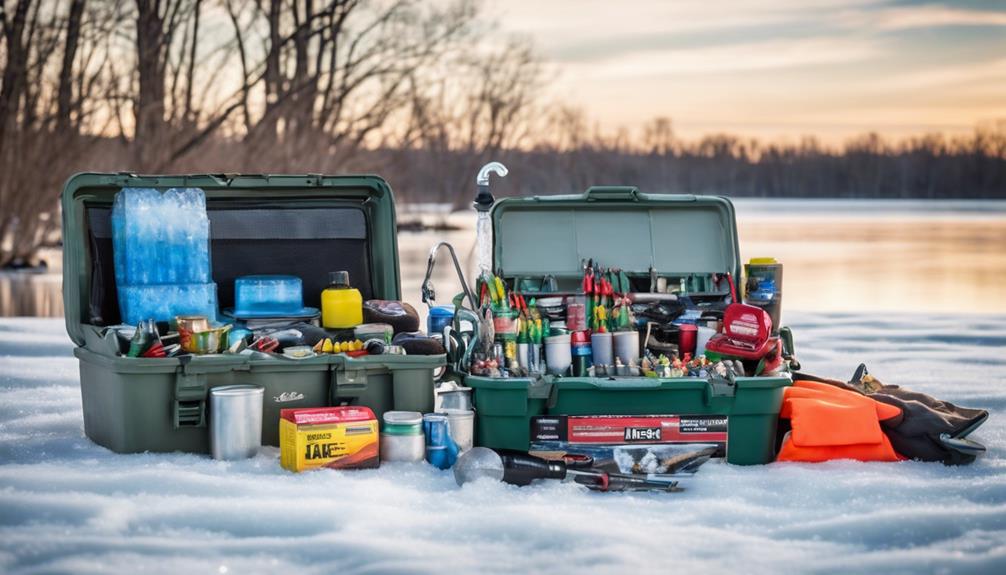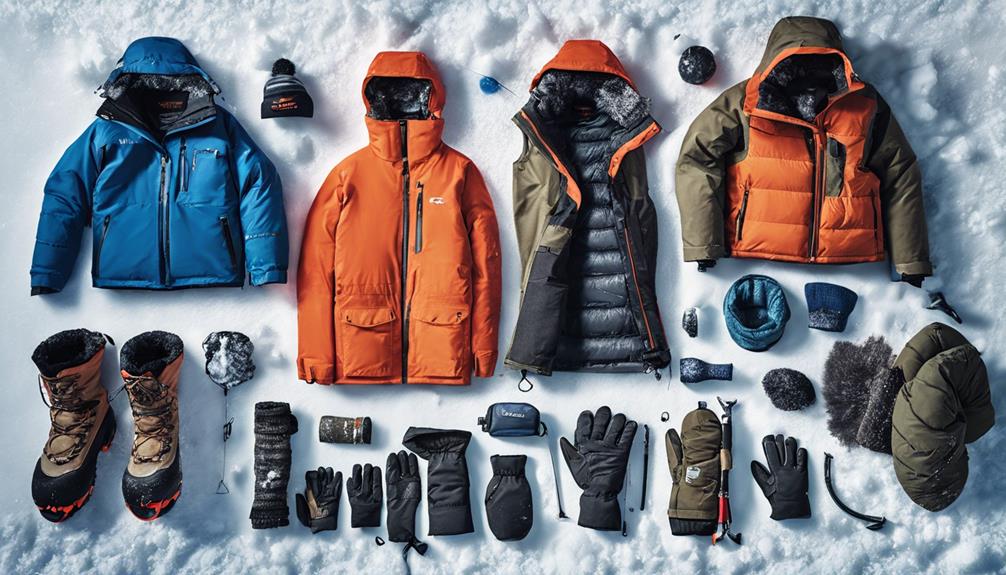When it comes to ice fishing, the success of your day on the frozen lake can pivot on a tiny piece of equipment – your lure.
The intricacies of selecting the right lure might seem overwhelming at first glance, but fear not, as we're here to guide you through this crucial decision-making process.
Understanding the nuances of fish behavior and the variety of lures available can significantly enhance your chances of a fruitful ice fishing session.
So, let's dive into the world of ice fishing lures and unravel the secrets to selecting the perfect one for your next icy adventure.
Factors to Consider
When selecting ice fishing lures, prioritize functionality over aesthetics to ensure effectiveness in catching fish. Consider the temperature tolerance of the lure you choose. Some lures are designed to perform better in colder temperatures, making them more suitable for ice fishing. Lures that can withstand extreme cold conditions without losing their effectiveness are essential for a successful ice fishing trip.
Another critical factor to consider is the thickness of the ice. Thicker ice requires lures that can penetrate through the hard surface to reach the fish below. Using a lure that's too light or delicate may not be able to break through the ice, leading to missed opportunities. Opt for lures that are sturdy and heavy enough to handle different ice thicknesses you may encounter.
When ice fishing, the conditions can be harsh, and having lures that can endure these conditions is crucial. Look for lures made from durable materials that can withstand the cold temperatures and potential rough handling. Additionally, choose lures that are easy to handle with gloves on, as dexterity can be limited in cold weather. By considering the temperature tolerance and ice thickness when selecting your ice fishing lures, you increase your chances of a successful and enjoyable fishing experience.
Understanding Fish Behavior
To improve your success in ice fishing, understanding fish behavior is key to effectively targeting and catching fish in the frozen waters. Fish behavior is greatly influenced by water temperature. During the winter months, fish tend to move to deeper waters where the temperature is more stable. Warmer water holds more oxygen, so fish will seek out these areas to conserve energy and stay comfortable. When ice fishing, it's crucial to consider the temperature influence on fish behavior.
Depth variation is another important aspect to understand when targeting fish beneath the ice. Different fish species have preferred depths where they're most active. For example, panfish like crappie and bluegill often stay closer to the bottom of the water column, while predatory fish like pike and walleye may be found at varying depths depending on factors like light penetration and water temperature. By knowing the preferred depth ranges of the fish you're targeting, you can improve your chances of a successful catch.
Types of Ice Fishing Lures
Exploring various types of ice fishing lures can significantly enhance your chances of attracting and catching fish in frozen waters. When selecting the right lure for ice fishing, considering the lure materials and popular designs can make a big difference in your success on the icy lake.
- Lure materials
- The choice of material can impact the lure's durability and effectiveness. Some common materials include plastic, metal, and wood. Each material has its unique characteristics that affect how the lure moves and attracts fish under the ice.
- Popular designs
- Ice fishing lures come in various designs tailored to different fish species and fishing conditions. From spoons and jigs to soft plastics and blade baits, each design has a specific action and presentation that can entice fish to strike.
- Blade baits
- Blade baits are effective for vertical jigging and creating vibrations that lure in fish even in cold, dark waters.
- Soft plastics
- Soft plastics mimic natural prey and can be rigged in different ways to imitate live bait, making them versatile options for ice fishing enthusiasts looking to experiment with presentations.
Matching Lures to Fish Species
Consider tailoring your choice of ice fishing lures to specific fish species to maximize your chances of a successful catch in frozen waters. Lure effectiveness can vary greatly depending on the species you're targeting. For example, if you're going after perch, small jigs like tungsten jigs or small spoons tend to work well due to perch's feeding habits. On the other hand, if you're aiming for larger predator fish like pike or walleye, using larger spoons or minnow-shaped lures may be more effective in enticing these species to strike.
Each fish species has its own preferences when it comes to the size, shape, and movement of lures. Panfish such as bluegill and crappie are often attracted to smaller, more subtle presentations like tiny jigs or soft plastics. In contrast, trout may respond better to lures that mimic natural baitfish movements, such as inline spinners or minnow imitations.
Understanding the species you're targeting can significantly increase your chances of a successful ice fishing outing. By selecting lures that align with the species preferences, you can enhance the effectiveness of your fishing efforts and improve your overall catch rates. So, next time you head out onto the ice, consider the specific fish species you're after and choose your lures accordingly for a more productive fishing experience.
Color Selection Tips
Tailor your lure color selection to match the preferences of the fish species you're targeting for optimal success in ice fishing. Understanding how light reflection and water clarity affect visibility underwater will help you choose the most effective colors for your ice fishing lures. Here are some color selection tips to enhance your chances of a successful ice fishing trip:
- Consider Light Reflection: Light reflection plays a crucial role in how fish perceive your lure underwater. Bright colors like chartreuse and orange can be highly visible in low light conditions, while darker colors like black and purple can stand out in clearer waters.
- Evaluate Water Clarity: The clarity of the water you're fishing in will determine how well fish can see your lure. In murky or stained waters, opt for vibrant colors that create contrast against the surroundings. In clear waters, natural colors like white, silver, or blue can mimic real baitfish effectively.
- Experiment with Fluorescent Hues: Fluorescent colors can be particularly effective in attracting fish attention, especially in deeper or darker waters where light penetration is limited.
- Adapt to Changing Conditions: Be prepared to switch up your lure colors based on weather conditions, time of day, and the behavior of the fish. Stay observant and adjust your color choices accordingly to maximize your chances of a successful catch.
Size and Weight Matters
When selecting ice fishing lures, pay attention to the size and weight for optimal performance in varying fishing conditions. The size and weight of your lure play a crucial role in determining how it behaves underwater. Different sizes and weights can affect how deep your lure dives, how it moves, and how fish perceive it. To achieve the best results, consider the technique variation and depth adjustment based on the specific conditions you're fishing in.
Technique variation is key when it comes to using ice fishing lures effectively. Lighter lures are ideal for a more finesse approach, allowing for subtle movements that can entice cautious fish in clear waters. On the other hand, heavier lures are better suited for aggressive jigging techniques, creating more vibrations and movements to attract fish in murky or deep waters. By understanding how the size and weight of your lure impact your fishing technique, you can adapt your methods to increase your chances of success.
Depth adjustment is another important factor to consider when selecting the right size and weight for your ice fishing lure. Lighter lures generally stay higher in the water column, making them suitable for shallow waters or when fish are suspended at mid-depths. Heavier lures, on the other hand, sink faster and can reach greater depths, making them more effective for targeting fish holding near the bottom. By choosing the appropriate size and weight for the depth you're fishing at, you can effectively present your lure to the fish where they're most likely to strike.
Best Lure Presentation Techniques
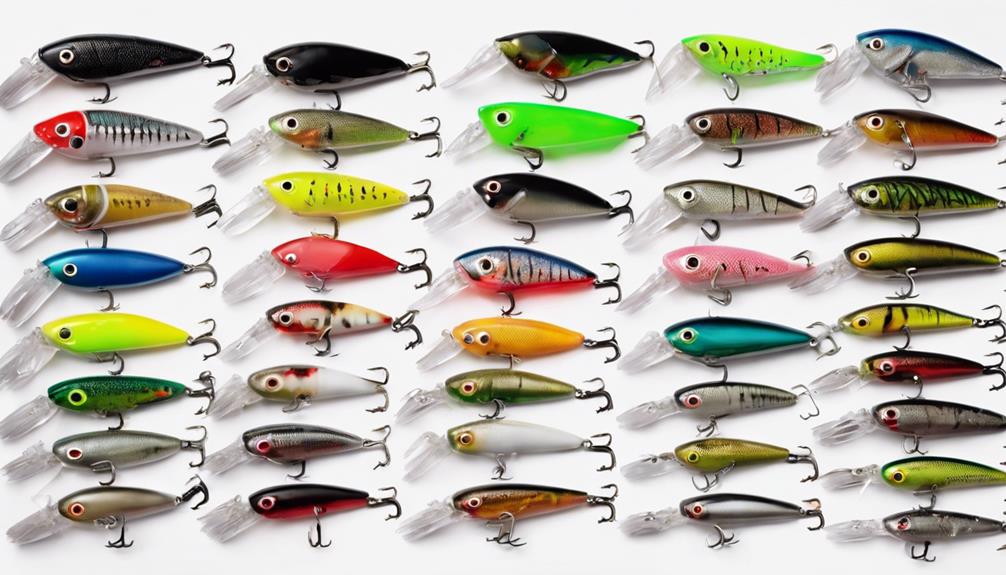
To enhance your ice fishing experience, master the art of employing various lure presentation techniques. When it comes to ice fishing, how you present your lure can make all the difference in your success on the ice. Here are some key techniques to consider:
- Jigging Techniques: Experiment with different jigging motions to entice fish. Try a combination of short, sharp jerks and slower lifts to mimic injured prey and attract bites.
- Depth Control: Pay attention to the depth at which you're fishing and adjust your presentation accordingly. Fish are often found at different depths depending on the time of day and weather conditions.
- Live Bait: Using live bait can add a realistic element to your presentation. Minnows, worms, or other live bait can be very enticing to fish, increasing your chances of a successful catch.
- Artificial Bait: Artificial lures come in a variety of shapes, sizes, and colors. Experiment with different types to see what the fish in your area respond to best.
DIY Ice Fishing Lure Ideas
For creative anglers looking to personalize their ice fishing experience, crafting your own ice fishing lures can be a rewarding and cost-effective option. Homemade designs offer a unique touch to your ice fishing gear, and they can be tailored to suit your specific fishing needs. Here are some creative alternatives to consider when making your DIY ice fishing lures.
One popular homemade design is creating jigs using common household items like bottle caps, screws, or even small toys. By repurposing these items and adding hooks, beads, and paint, you can craft custom jigs that mimic the movements of natural prey.
Another creative alternative is making ice fishing spoons from old silverware. Simply bend the handle of a spoon to form a loop for attaching a hook, add some flashy accents like beads or sequins, and you have a unique and effective lure.
If you enjoy experimenting with different materials, consider crafting soft plastic baits using molds and melted plastic. This DIY approach allows you to customize the color, size, and texture of your lures, giving you an edge in enticing fish in your area.
Frequently Asked Questions
Can Ice Fishing Lures Be Used for Open Water Fishing as Well?
Yes, ice fishing lures can be used for open water fishing as well. Their versatility allows for transitioning between fishing seasons without needing to change your entire lure selection.
These lures can be effective in open water situations, especially when targeting certain fish species.
Are There Any Specific Lures That Work Better in Different Ice Fishing Locations (E.G. Lakes Vs Rivers)?
When it comes to ice fishing locations like lakes versus rivers, certain lures can work better depending on where you are. Lakes may favor larger, flashier lures to catch the attention of fish in deeper waters, while rivers might benefit from smaller, more subtle options that mimic natural prey.
Understanding these differences in effectiveness can help you choose the right lures for your specific ice fishing location preferences.
How Long Do Ice Fishing Lures Typically Last Before Needing to Be Replaced?
Ice fishing lures typically last a good while before needing replacement. To keep them in top shape, it's important to maintain them properly.
Store your lures in a cool, dry place to ensure longevity. Regularly check for any damage or wear and tear, and if needed, make repairs or replace them.
Are There Any Specific Techniques for Storing Ice Fishing Lures to Keep Them in Good Condition?
To keep your ice fishing lures in good shape, proper storage is key. Store them in a dry place and avoid extreme temperatures.
To maintain your lures, rinse them with fresh water after use and let them dry completely before storage. Check for any damage or rust regularly.
What Are Some Common Mistakes That Beginners Make When Selecting Ice Fishing Lures?
When choosing ice fishing lures, beginners often make mistakes by picking flashy lures without considering the fish species or water conditions. Remember, lure selection should match the prey and environment.
Avoid the error of using oversized lures that scare off fish. Opt for smaller options that mimic local baitfish.
Another common blunder is overlooking the importance of varying lure sizes and colors based on the season and weather conditions. Stay adaptable for better fishing success.
Conclusion
Now that you have a better understanding of the factors to consider when choosing ice fishing lures, as well as some tips on matching them to fish species and presentation techniques, you're ready to hit the ice with confidence.
Remember to pay attention to details like color selection, size, and weight to maximize your chances of success. Whether you prefer store-bought lures or DIY creations, the key is to have a variety of options to adapt to changing conditions on the ice.
Happy fishing!
